Panasonic Lumix GX850 Review
Panasonic Lumix GX850 Introduction
The Panasonic Lumix GX850 is a miniature mirrorless camera. It is the lightest Micro Four-Thirds digital camera and also the smallest. While not following it in name, the GX850 replaces the GM1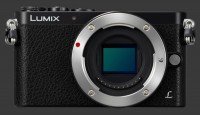
Panasonic Lumix DMC-GM1 with a completely new imaging pipeline within a similar body. Despite its diminutive size and limited number of external controls, the Panasonic GX850 is a full-featured mirrorless.
This mirrorless is built around a 16 megapixels Four-Thirds CMOS sensor with native ISO 200-25600 sensitivity range, expandable to include ISO 100. The sensor can output full-resolution images at 10 FPS or 4K Ultra-HD video at 30 FPS, something that Panasonic takes advantage of better than anyone with their unique 4K Photo Mode and now also Focus Stacking. More details on these features further down.
In additional to Manual Controls featured on all mirrorless cameras, the GX850 offers plenty of additional functionality. These include AEB of up to 7 frames, Multiple Exposure, Time Lapse, Stop Motion, Sweeping Panorama and a sophisticated 49-Point Contrast-Detect AF system with Tracking, Eye/Face-Detection, Custom Area, Pin-Point and DMF modes.
The diminutive body of the Panasonic GX850 squeezes in a 3" LCD mounted on a 180° tilting hinge, plus a built-in popup flash. A single control-dial at the rear, a standard mode-dial and a few other buttons round-off the interface of this mirrorless digital camera.
The Panasonic GX850 offers plenty of advantages over compact cameras. Most notably, interchangeable lenses. With a small collapsible lens, the GX850 stays smaller than the majority of premium cameras which do not offer this flexibility. It has access to the full lineup of Micro Four-Thirds lenses.
This digital camera review analyses the usability, image quality and performance of the Panasonic Lumix GX850.
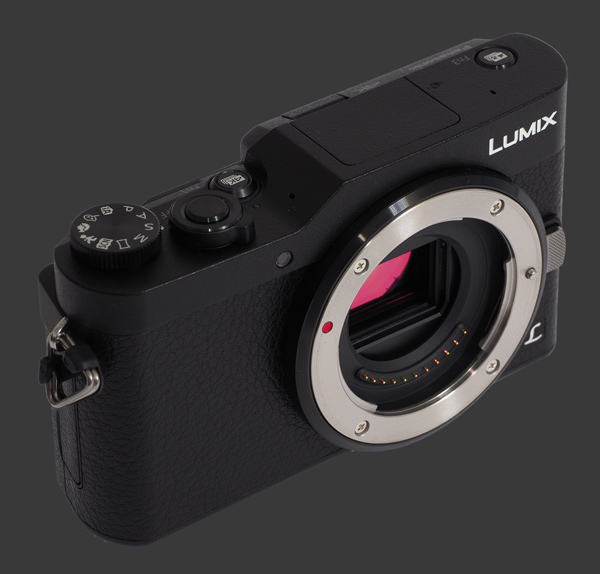
Panasonic Lumix GX850 Features
Sensor
- 16 Megapixels CMOS Four-Thirds sensor
- 2X Crop-Factor, 4:3 Aspect-Ratio
- Micro Four-Thirds lens mount
- Built-in Dust-Reduction
Exposure
- ISO 200 - 25600, Expandable to ISO 100
- Intelligent & Standard Auto ISO
- Customizable Auto ISO Limit, 400 - 25600
- 1/16000 - 60s Hybrid Shutter
- 1/16000 - 1s Electronic-Shutter
- 1/500 - 60s Electronic Front-Curtain Shutter
- Bulb Exposure mode, called Timed here
- PASM Exposure modes with Program-Shift
- Multi-Segment, Center-Weighed and Spot metering
- Exposure-Compensation, ±5, 1/3 EV increments
- AEB, 3 - 7 frames, 1/3 - 1 EV increments
- Forced, Redeye, Slow-Sync, Slow-Sync Redeye, Off flash modes
- Flash-Compensation, ±2, 1/3 increments
- First or second curtain Flash-Sync
Image Parameters
- Automatic, 5 presetsSunny, Cloudy, Shade, Tungsten, Flash, Kelvin and 4 Custom White-Balance memories
- White-Balance Fine-Tuning, 19 steps, 2 axis
- WB Bracketing, 3 frames, 3 step sizes, 2 axis
- Adjustable Contrast, Sharpness, Saturation and Noise-Reduction, 11 steps each
- 5 Color and 2 B&W modes
- sRGB or Adobe RGB color spaces
Drive
- 5.8 FPS Mechanical-Shutter drive with preview
- 10 FPS Electronic-Shutter drive without preview
- Maximum 100 JPEG or 15 RAW
- 30 FPS Drive @ 4 MP, Max 60 JPEG
- Self-timer, 2s, 10s or 3 shots @ 10 seconds
- Interval-Timer, 1 - 9999 frames, 1s to 100 minute interval, immediate or delayed start
- Multiple-Exposure, Max 4 frames
- Automatic HDR, Auto or 1 - 3 EV steps
- Optional Auto Gain for Multiple-Exposure
- Optional Auto Align for HDR capture
Focus
- 49-Point Contrast-Detect AF system
- Single-Shot Autofocus, Continuous Autofocus, DMF or standard Manual-Focus
- Pinpoint, Center-Area, Custom-Area, 9-Area Focus-Selection
- 8 Focus-Area sizes
- Optional Quick AF
- Optional AF-Assist Lamp
- Optional MF-Assist
Display
- 3" Tilting Touchscreen LCD, 1 megapixel
- Optional Live-Histogram
- Optional Blinking-Highlight
- Optional Framing-Guidelines, 3 types
- Optional Focus-Peaking, 2 levels
- Adjustable brightness, 7 steps
- Adjustable saturation, 7 steps
- Adjustable color, 11 steps, 2 axis
Output Processing
- 3:2, 16:9 & 1:1 Cropped aspect-ratios
- 16, 8 and 4 Megapixels mode
- JPEG, RAW, RAW+JPEG capture
- 2 JPEG Compression qualities
- Optional Long-Shutter Noise-Reduction
- Optional Contrast Enhancement, 3 levels
- Optional Resolution Enhancement, 4 levels
- Optional Diffraction Compensation
- Optional Vignetting Correction
Video
- 3840x2160 @ 30 FPS MPEG-4
- 1920x1080 @ 60 FPS MPEG-4 or AVCHD
- 1280x720 @ 30 FPS MPEG-4
- Built-in stereo microphone
- Adjustable Audio-Input, 4 levels
- Optional Audio-Meter, 2 channels
- Optional Wind-Filter, 2 levels
Connectivity
- HDMI (4K) output
- USB 2.0 connectivity
- WiFi (802.11b/g/n)
Misc
- Single control-dials
- Traditional mode-dial
- 3 Customizable button
- Built-in charging-circuit
- Lithium-Ion battery
- MicroSDXC memory
Panasonic Lumix GX850 Usability - How easy is it to use?
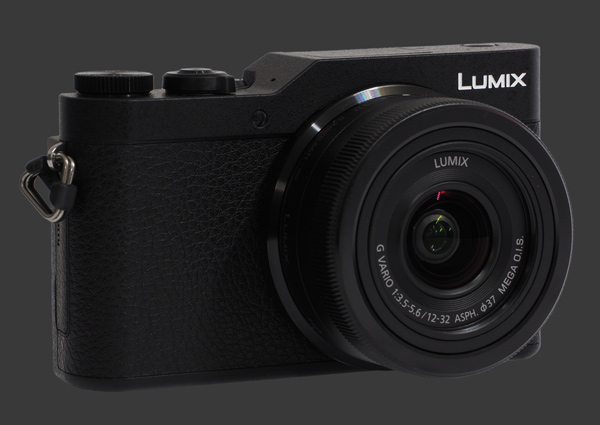
Panasonic made the GX850 incredibly small for a mirrorless. In fact, it is about the size of an average compact camera yet very few cameras this small have any manual-controls, let alone advanced features such as bracketing, interval timer, time lapse, stop motion and timed exposure.
The rectangular body offers no grip at all, just a flat and slightly-textured surface, making this camera precarious to hold. As with other mirrorless cameras, it is expected to be held with two hands, so there is less risk of it falling. An eyelet on each side allow the use of the supplied neck-strap, but one would probably use a wrist-strap instead with such a small camera.
Given how short the body is, one ends up with a cramped two-finger hold on the front. Still, the GX850 is incredibly light and will not be tiresome without a bulky lens attached. With the 12-32mm F/3.5-5.6 OIS kit-lens, it is a truly feather-weight while offering far better image-quality than any similarly-sized offering.
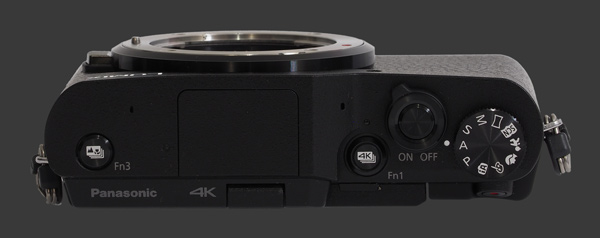
The top plate of the GX850 has been completely redesigned compared to the GM1. It is split into two levels with a slope that separates the built-in flash from most controls. Near the left edge there is a customizable Fn3 button which defaults to toggle Post Focus mode but there are an incredible 43 options to choose from! The popup flash finds itself behind a panel aligned with the optical center of the lens. It is released by the smallest Flash-Release switch ever which is nearly invisible along the upper edge of the camera. To the right of the slope, there is the Fn1 customizable button which defaults to 4K Photo mode but can be set to any of the same 43 functions as Fn3.
Further right on the top plate, one finds a standard two-stage shutter-release button. It has moderate travel to a firm halfway point. Around it there is a rotating power switch. The last remaining control on the top-plate is a standard Mode Dial. The ubiquitous PASM modes are all there, plus a fully automatic mode, a Filter mode, a Portrait mode, a Sports mode, a position to groups all 21 Scene modes and a Panorama mode. Strangely, both Portrait and Sport modes force the use of Portrait Picture Style. Panorama mode only supports horizontal sweeping which is unusually restrictive. The Mode Dial has nice and firm detents to prevent accidental changes.
Notably absent from the Mode Dial is a Video mode. This is a major setback compared to the GM1. While there is a reasonable amount of video features on the camera, it is never ready to record video. Framing is impossible to preview correctly for both video and images as one must choose the aspect-ratio displayed on the LCD.
Given that the GX850 has a limited number of external controls, a number of features are not accessible at all without assigning them to a function button. These include Depth-of-Field Preview, AF-On, AE/AF-L and Level Gauge among others. Some key features are changeable through the menu system yet quite inefficient to use. ISO and Focus Mode are probably the two most crucial ones, so it is best to assign them to Fn1 and Fn3, respectively.
High-speed output from the sensor in the GX850 makes 4K Photo and Post Focus modes possible. 4K Photo captures a stream of 4K images and saves it as a sequence with an option for prebuffering, as we have seen on other Panasonic digital cameras before. Post Focus allows an image to be refocused or rendered with a different depth-of-field after it has been captured. It works by storing a short 4K video that records the camera focusing at all 49 AF-areas. There is a slight crop but the 4:3 aspect-ratio is preserved, so images are not identical to frames from an 4K video. Once captured, it is possible to change the focus point or do Focus Stacking on all the frames.
Here is image of a donkey focused on its head:
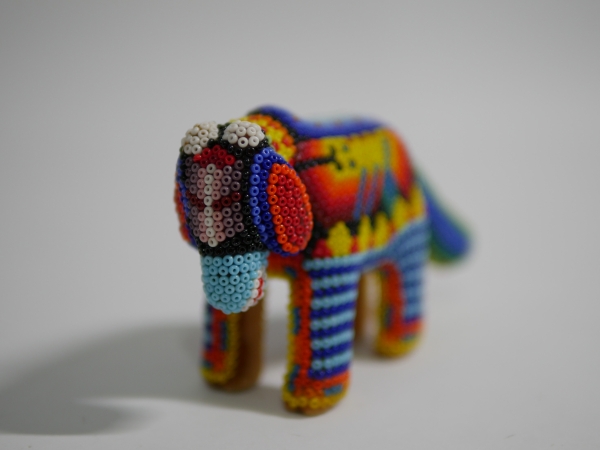
Now the same donkey with Focus Stacking applied to a Post Focus image:
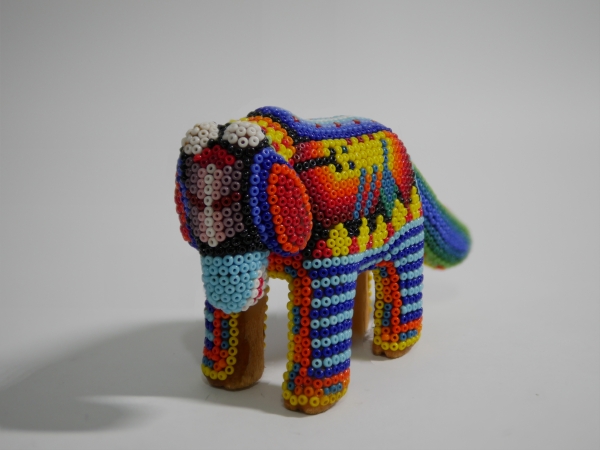
The results are outstanding. While not rendering an infinite depth-of-field, the majority of the subject is perfectly sharp. This is immensely helpful for product and macro photography. Doing the same without camera support is very cumbersome since one must manually adjust focus between each frames without moving the camera at all.
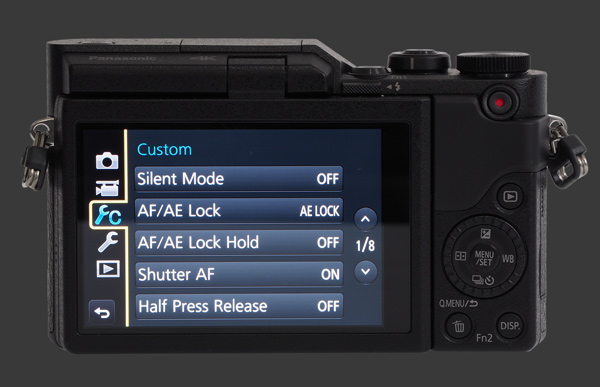
All remaining controls are located on the back of the camera which is dominated by a large 3" touchscreen LCD. The display is bright and, at 1 megapixel of resolution, extremely sharp. The screen is mounted to a camera with a small yet sturdy tilting hinge that can rotate upwards 180°. Unfortunately, it is not Exposure-Priority except in Manual exposure-mode and only when the Constant Preview option is enabled from the Custom setting menu. At least it shows 100% coverage and previews WB correctly though.
To the right of the LCD, there is room for about half-a-thumb next to the Video-Record and Playback buttons. Both of these are slightly flush to the camera surface to prevent accidental use which also makes them unusable with gloves on. The Video-Record button can be disabled but not reconfigured to anything else. The Playback button works like usual.
Just below, there is a 4-way controller with central MENU/SET button. Each direction is assigned a dedicated function:
- Up: Starts EC, except in Manual mode where it switches between Aperture and Shutter-Speed. Press SET to return to normal.
- Right: Selects White-Balance. Press Down to Fine-Tune WB ±9 along A-B and G-M axis..
- Down: Selects a drive mode: Off, Single, Burst10 FPS without Live-View, 5.8 or 3 FPS with Live-View, 4K Photo, Post Focus and Self-Timer2s, 10s or 3-frames at 10s. There is no difference between Off and Single.
- Left: Selects the AF mode: Pinpoint, Single-Area, Custom Area Group, 3x3 Area Group, Tracking and Eye/Face-Detect. The focus point or area, depending on the mode, can be set by pressing Down from there. Pinpoint selects an exact point while Single-Area selects an area in eight sizes.
Around the 4-way controller, there is an extremely thin control-dial. This is the only one on the GX850 and is rather flimsy. In Capture mode, it controls the active exposure parameter. In Playback mode, it magnifies images. It can also be used to navigate the menu. The control-dial has soft detents and is ribbed to provide some grip but is insufficient for use with gloves on.
Along the lower-edge of the camera, there are two more buttons. One is Q.MENU which brings up 2 rows of icons to access some photographic controls. The same button is used to back-out of sub-menus and to delete images and videos, depending on the context. The other button, DISP, cycles over display modes in Capture and Playback. There are quite a few display options on the GX850. A 2-Axis digital level overlay is available. It is accurate, easy to see and unobtrusive. Exactly how it should be! There is a MF Assist function which magnifies part of the frame to full-screen or PIP to keep an eye on framing. Focus-Peaking can optionally be enabled. There is a Live-Histogram which sadly shows the display distribution instead of being based on exposure.
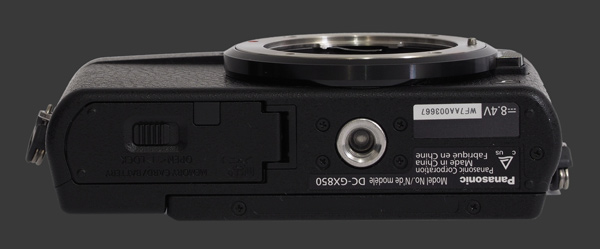
The bottom of the camera features a metal tripod mount which is perfectly aligned with the optical axis. There is also a rather flimsy plastic door which covers the combined battery and memory-card compartment. The GX850 is one of the few mirrorless cameras to use MicroSDXC cards rather than full-size ones. The bottom of the lens mount is flush with the base of the camera, so many lenses exceed it which makes it difficult to mount the camera on a tripod.
There is an internal charging circuit in the Panasonic Lumix GX850. Unfortunately a charger is not provided with the camera, so it gets tied up when charging a battery. Strangely, the camera refuses to charge the battery when it is on. One must turn the camera off for it to charge, otherwise it connects to a host computer.
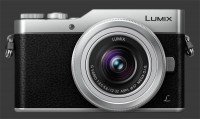 |
Please Support Neocamera
All information on Neocamera is provided free of charge yet running this website is a huge endeavor. Purchases made via affiliate links found throughout the site help keep it running and up-to-date. There is no additional cost to you, so please consider buying via these links to our affilates:
If you found any information on this site valuable and did not purchase via our affiliate links, please considering donating via PayPal:
Any amount will be greatly appreaciated. Thank you for your support!
Panasonic GX850 Highlights

Sensor-Size: 17 x 13mm

Actual size when viewed at 100 DPI
| 16 Megapixels Mirrorless | ISO 100-25600 |
| Micro Four-Thirds Mount 2X FLM | Shutter 1/16000-60s |
| 2 Axis Digital Level | Full manual controls, including Manual Focus |
| Built-in Dust Reduction | Custom white-balance with 2 axis fine-tuning |
| 10 FPS Drive, 15 Images | Spot-Metering |
| 3840x2160 @ 30 FPS Video Recording | Lithium-Ion Battery |
| 3" LCD 1 Megapixels | Micro Secure Digital Extended Capacity |
Updates
2024.04.03

Fujifilm X-T5 Review
Newest Fujifilm flagship boasting a 40 MP APS-C sensor, 5-axis IBIS with 7-stop efficiency, 15 FPS continuous drive, 6.2K Video capture, dual control-dials and dual SDXC UHS-II slots in a sturdy weatherproof and freezeproof body.
2023.11.20

Best Digital Cameras of 2023
Find out which are the Best Digital Cameras of 2023. All the new Mirrorless Digital Cameras from entry-level to high-end professional.
2023.07.10

Fujifilm X-H2 Review
40 Megapixels APS-C Hybrid Mirrorless Digital Camera with 7-stop IBIS. Fastest shutter ever and 8K video capture. Large builtin EVF with 0.8X magnification and 5.8 MP, plus an Eye-Start Sensor. Packed with features and large number of controls in a weatherproof and freezeproof body.
2023.05.07

Sony FE 20-70mm F/4G Review
Review of the unique Sony FE 20-70mm F/4G lens. The optical zoom of this lens spans ultra-wide-angle and medium focal-length coverage, making it one of the most versatile Full-Frame lenses on the market.
2023.01.15

Huion Inspiroy Dial 2 Review
Review of the Huion Inspiroy Dial 2 tablet, a medium sized drawing surface with dual dials and customizable buttons. Connects via USB-C or Bluetooth 5.0 with Windows, Linux and Android support.
2022.12.08

How to Pack for a Photo Trip
Find out how to pack for a travel photography trip, carry your gear safely while meeting airline regulations.
2022.11.13

Best Digital Cameras of 2022
The best digital cameras of 2022. A short list of the most outstanding models in their respective categories. Choose one for yourself or as a gift.
2022.09.21

Pentax DA* 60-250mm F/4 SDM Review
Review of the Pentax DA* 60-250mm F/4 SDM, the constant-aperture telephoto zoom with the highest zoom-ratio on the market.
2022.09.20

Pentax DA* 50-135mm F/2.8 SDM Review
Review of the Pentax DA* 50-135mm F/2.8 SDM, the lightest professional telephoto zoom native to the K-mount.
2022.09.10

Pentax DA* 11-18mm F/2.8 DC AW Review
Review of the Pentax DA* 11-18mm F/2.8 DC AW, the widest professional ultra-wide zoom native to the K-mount.
2021.11.24

50 Gifts Under $50 For Photographers in 2021
50 Gifts photographers will love. All for under $50 USD. 2021 Edition.
2021.11.17

Best Digital Cameras for 2021
Neocamera shows which are the very best Digital Cameras for 2021 in every category: Mirrorless, DSLR, Premium Compact, Ultra-Zoom and Rugged.













